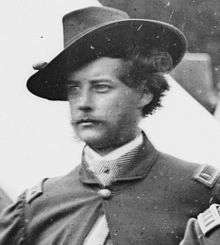William Neil Dennison
William Neil Dennison (December 10, 1841 – December 31, 1904) was a highly decorated artillery officer during the American Civil War, an attorney and business speculator during the postbellum years.
Early life
Born in Ohio, "Neil" was the son of Ohio Governor and Postmaster General of the United States William Dennison, Jr. and Anne (Neil) Dennison.

Civil War
At the outbreak of hostilities, his father served as the Governor of Ohio (1860–1862), and undoubtedly influenced Dennison's direct commission into the regular U.S. Army, on August 5, 1861. He was assigned to the 2nd U.S. Artillery, an organization whose officers corps produced both Chiefs of Artillery for the Army of the Potomac, and the who formed the backbone of the famed U.S. Horse Artillery Brigade.
Promoted to first lieutenant on November 12, 1861, Dennison served with the 2nd Artillery throughout the Civil War, almost entirely with the Horse Artillery Brigade. He gained most of his experience while serving as a section chief in Battery A, 2nd U.S. Artillery, under the command of Captain John C. Tidball. During the Peninsula Campaign, Dennison commanded the rear (left) section of Tidball's "flying battery." In 1864, Dennison commanded Battery G, and eventually returned to command Battery A until the end of the war. He was awarded two brevet promotions for gallantry in combat, including the ranks of captain (for actions at Gaines' Mill and Malvern Hill) and major (for actions at Antietam). At war's end, he received his final brevet promotion, to lieutenant colonel, for his overall service and conduct during the war.
Postwar career

Promoted to the permanent rank of captain in 1867, Dennison requested and received a discharge from the army in 1870. He appears to have dabbled in politics, perhaps hoping to follow in his father's successful career as Governor of Ohio and Postmaster General of the United States. His public reputation suffered due to unsavory business dealings with questionable acquaintances, and he lost the 1879 mayoral race in Columbus, Ohio.
He moved to Denver, Colorado, where he served as a district attorney and also dabbled in speculative mining and saloons. He was plagued with negative press and maintained somewhat of a rogue's reputation. His business partners, Sam and Lou Blonger, also owned gambling houses. Ultimately, he lost his position with the District Attorney's office.
Colonel Dennison was married to Mary Cole (or Catherine) Haldeman (October 20, 1851 - December 15, 1882), the daughter of Edwin Haldeman and Harriet Cole. They had four children. Dennison died December 31, 1904, and was buried in Green Lawn Cemetery, Columbus, Ohio.
References
- Heitman, Francis B. Historical Register and Dictionary of the United States Army, From its Organization, September 29, 1789 to March 2, 1903. Washington, DC: Government Printing Office, 1903.
- Johnson, Scott and Craig Johnson. "The Blonger Brothers.", 2006.
- Library of Congress Prints and Photographs Division, Washington, D.C.
- Simpson, W. A., History of the Second U.S. Artillery, 1900.
- U.S. War Department. The War of the Rebellion: A Compilation of the Official Records of the Union and Confederate Armies. Washington, DC: Government Printing Office, 1894.